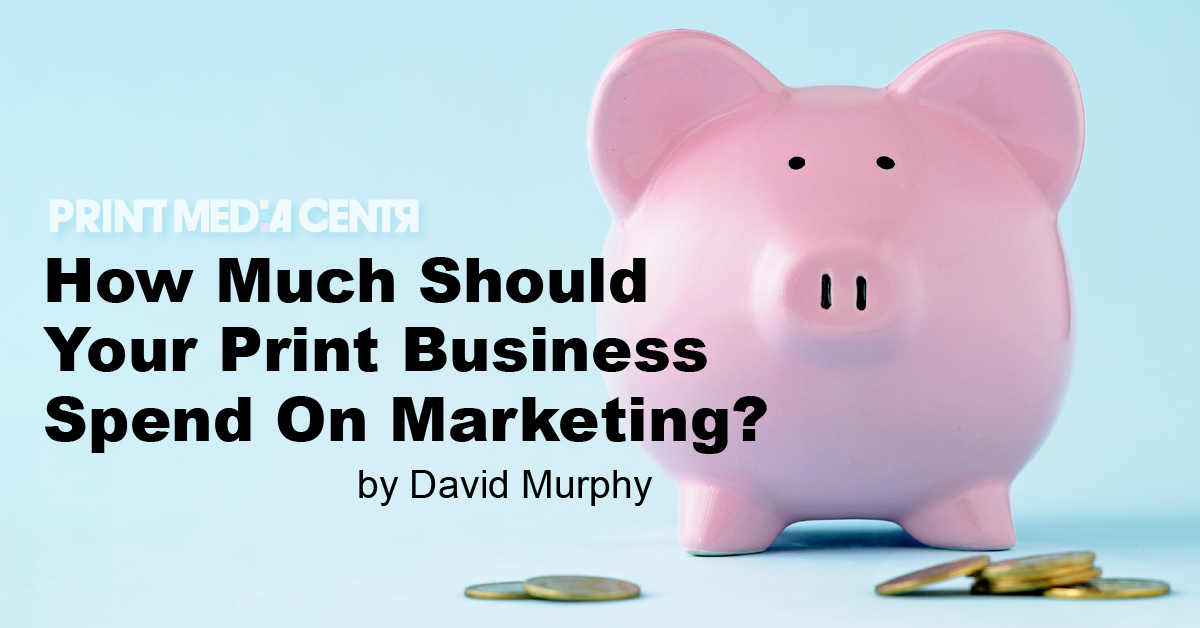A print industry friend of mine asked my opinion about how he should budget for marketing this year. I’ll share with you, my Print Media Centr friends, what I told him. While there isn’t a single right answer, there are some directional guidelines that companies use for marketing budgeting.

Many companies follow a percentage of revenue rule. There is a wide, general range of about 5-20% of revenue across all industries and environments. The average marketing budget is about 11% of revenue, but multiple factors offer guidance.
Maturity of business – Is the company in the early phase or is it well established? Across all industries, startups spend 12-20% of revenue, while more established companies average 6-12%.
Size of business – Smaller companies with less than $5 million in revenue and about 10-12% margin tend to spend 7-8% of their revenue on marketing.
Market focus – Consumer-based businesses tend to spend more on marketing than those selling to other businesses.
Internal marketing structure – Firms in which the marketing department has responsibility for revenue generation tend to spend more on marketing than those in which the sales department owns it.
Average margins – Where competition is greater (and subsequently margins are lower), marketing spend is often higher. This seems a little counterintuitive, but it’s a part of the struggle for marketing funds that lower-margin companies often face.
Metrics for success – Companies with a dedicated focus on ROI tend to use more analytics, have clear KPIs, and review campaign performance more rigidly. These companies typically spend more on marketing.
Role of digital marketing and social media – Do new leads drive immediate sales? If so, marketing spend should be a little higher. This tends to be more common for e-commerce companies in which average order size is lower and personalized account management is less necessary.
After all, the bottom line in determining how much to invest in marketing should be largely determined by how effective your marketing is in driving your objectives. Poor marketing strategy and execution should be poorly funded – and vice versa. Marketing is an investment, not an expense. If your marketing investment generates the optimal profit you desire and helps achieve your company’s overall goals, you’re doing it right. You may disregard this article.
 David Murphy is the founder and CEO of Nvent Marketing, a marketing agency specializing in digital marketing for the print industry. David has 30+ years of experience in the graphics and document print production industry. He has served as a board member and advisor to print organizations and associations including Sustainable Green Printing Partnership (SGP), Print Industries of America (PIA), Association for Print Technologies (APTECH), and Electronic Document Scholarship Foundation (EDSF). David was also awarded the Idealliance Soderstrom Society Award for Print Industry Leadership. David can be reached at [email protected].
David Murphy is the founder and CEO of Nvent Marketing, a marketing agency specializing in digital marketing for the print industry. David has 30+ years of experience in the graphics and document print production industry. He has served as a board member and advisor to print organizations and associations including Sustainable Green Printing Partnership (SGP), Print Industries of America (PIA), Association for Print Technologies (APTECH), and Electronic Document Scholarship Foundation (EDSF). David was also awarded the Idealliance Soderstrom Society Award for Print Industry Leadership. David can be reached at [email protected].










One Response
Good guidelines to an oft-asked question. Sadly, the print industry has spent very reluctantly on marketing and it shows.
One bit of advice I would add is that rather than percentages, do your homework and spend according to the size of the opportunity.